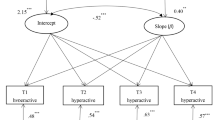Abstract
Matched pairs of hyperactive and normally active children were observed in six natural classroom settings and a number of specific behaviors continuously recorded. Both groups of children showed differences in behavior as a function of settings (selected to vary in amount of external stimulation and structure), but only certain settings differentiated hyperactive from control children. Hyperactive children displayed significantly more noise-vocalization and more disruptive and off-task behavior in the most frequently observed (low stimulation) classroom settings (e.g., seat work). Type of off-task behavior (out-of-seat or visually off-task) depended upon amount of classroom structure (i.e., teacher- vs. self-directed). Results were discussed in terms of their implications for identification and treatment of hyperactive children through the modification of the antecedent conditions of stimulation and structure.
Similar content being viewed by others
Reference notes
Zentall, S. S., & Leib, S.Structured tasks: Effects on activity and performance of hyperactive and normal children. Manuscript submitted for publication.
Zentall, S. S., & Shaw, J. H.Classroom noise effects on math performance and activity of hyperactive and normally active second grade children. Manuscript submitted for publication.
References
Ambrosino, S., & Del Fonte, T. A. A psychoeducational study of the hyperkinetic syndrome.Psychosomatics, 1973,14, 207–213.
Baumeister, A., & Forehand, R. Stereotyped acts. In N. R. Ellis (Ed.),International review of research in mental retardation (Vol. 6). New York: Academic Press, 1973.
Blunden, D., Spring, C., & Greenberg, L. M. Validation of the classroom behavior inventory.Journal of Consulting and Clinical Psychology, 1974,42, 84–88.
Bryan, T. S. An observational analysis of classroom behaviors of children with learning disabilities.Journal of Learning Disabilities, 1974,7, 35–43.
Bryan, T. S., & Wheeler, R. Perception of learning disabled children: The eye of the observer.Journal of Learning Disabilities, 1972,5, 484–488.
Buchan, B., Swap, S., & Swap, W. Teacher identification of hyperactive children in preschool settings.Exceptional Children, 1977,43, 314.
Conners, C. K. Minimal brain dysfunction and psychopathology in children. In A. Davis (Ed.),Child psychopathology and personality: Current topics. New York: Wiley, 1975.
Copeland, A. P., & Weissbrod, C. S. Behavioral correlates of the hyperactivity factor of the Conners Teacher Questionnaire.Journal of Abnormal Child Psychology, 1978,6, 339–343.
Davids, A. An objective instrument for assessing hyperkinesis in children.Journal of Learning Disabilities, 1971,4, 35–37.
Douglas, V. I. Stop, look and listen: The problem of sustained attention and impulse control.Canadian Journal of Behavioral Science, 1972,4, 259–282.
Douglas, V. I., & Peters, K. G. Toward a clearer definition of the attentional deficit of hyperactive children. In G. A. Hale & M. Lewis (Eds.),Attention and cognitive development. New York: Plenum, in press.
Forness, S. R., & Esveldt, K. C. Prediction of high-risk kindergarten children through classroom observation.Journal of Special Education, 1975,9, 375–387.
Herbert, J., & Attridge, C. A guide for developers and users of observation systems and manuals.American Educational Research Journal, 1975,12, 1–20.
Kaspar, J. C., Millichap, J. G., Backus, D. C., Child, D., & Schulman, J. L. A study of the relationship between neurological evidence of brain damage in children and activity and distractibility.Journal of Consulting and Clinical Psychology, 1971,36, 329–337.
Lahey, B. B., Stempniak, M., Robinson, E. J., & Tyroler, M. J. Hyperactivity and learning disabilities as independent dimensions of child behavior problems. In B. B. Lahey (Ed.),Behavior therapy with hyperactive and learning disabled children. New York: Oxford University Press, 1979.
Pope, L. Motor activity in brain injured children.American Journal of Orthopsychiatry, 1970,40, 783–793.
Rapoport, J. L., & Benoit, M. The relation of direct home observations to the clinic evaluation of hyperactive school age boys.Journal of Child Psychology and Psychiatry, 1975,16, 141–147.
Rich, H. L. Teachers perceptions of motor activity and related behaviors.Exceptional Children, 1978,45, 210–211.
Safer, D. J., & Allen, R. P.Hyperactive children: Diagnosis and management. Baltimore: University Park Press, 1976.
Schulman, J. L., Kaspar, J. C., & Throne, F. M.Brain damage and behavior: A clinical-experimental study. Springfield, Illinois: Charles C Thomas, 1965.
Werry, J. S., & Quay, H. C. Observing the classroom behavior of elementary school children.Exceptional Children, 1969,35, 461–470.
Whalen, C. K., & Henker, B. Psychostimulants and children: A review and analysis.Psychological Bulletin, 1976,83, 1113–1130.
Williams, B. J., Vincent, J. P., & Elrod, J. T.The behavioral components of hyperactivity. Paper presented at the meeting of the American Psychological Association, San Francisco, August 1977.
Zentall, S. S. Optimal stimulation as theoretical basis of hyperactivity.American Journal of Orthopsychiatry, 1975,45, 549–563.
Zentall, S. S. Environmental stimulation model.Exceptional Children, 1977,43, 502–510.
Zentall, S. S., & Barack, R. S. Rating scales for hyperactivity: Concurrent validity, reliability, and decisions to label for the Conners and Davids abbreviated scales.Journal of Abnormal Child Psychology, 1979,7, 179–190.
Zentall, S. S., & Zentall, T. R. Activity and task performance of hyperactive children as a function of environmental stimulation.Journal of Consulting and Clinical Psychology, 1976,44, 693–697.
Zentall, S. S., Zentall, T. R., & Barack, R. S. Distraction as a function of within-task stimulation for hyperactive and normal children.Journal of Learning Disabilities, 1978,11, 540–548.
Zentall, S. S., Zentall, T. R., & Booth, M. E. Within-task stimulation: Effects on activity and spelling performance in hyperactive and normal children.Journal of Educational Research, 1978,71, 223–230.
Author information
Authors and Affiliations
Additional information
This research was funded by a research grant from Eastern Kentucky University, in cooperation with Model School in Richmond, Kentucky; Stephen Traw, the director; JoAnn Walker, the elementary guidance counselor; and the teachers. The author is grateful to Marlene White, Billie Nunn, Rebekah Streshley, and Diane Dreschler for their assistance in data collection. Thanks are also extended to Steven Falkenberg and Bruce Lewis for their consultations on data analysis and computer processing. The author would like to acknowledge Sharon Walton and Martha Marcum for their help in typing this manuscript.
Rights and permissions
About this article
Cite this article
Zentall, S.S. Behavioral comparisons of hyperactive and normally active children in natural settings. J Abnorm Child Psychol 8, 93–109 (1980). https://doi.org/10.1007/BF00918164
Issue Date:
DOI: https://doi.org/10.1007/BF00918164




